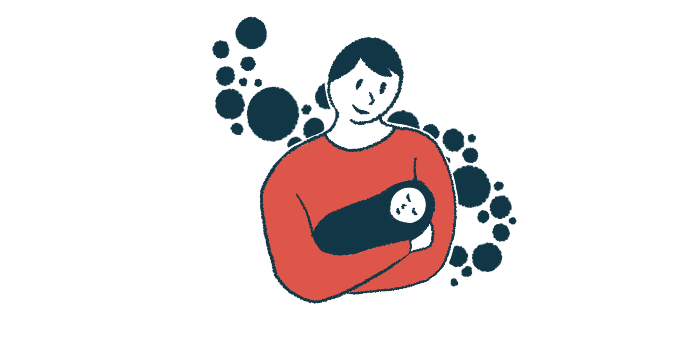1st Case to Report Newborn With 2 Genetic Disorders: Pompe, Sickle Cell
Boy treated with ERT for Pompe and blood transfusions for sickle cell disease
Written by |

A newborn boy was diagnosed with both infantile-onset Pompe disease (IOPD) and sickle cell disease (SCD) in the first case study to report two co-existing genetic disorders.
The boy was given enzyme replacement therapy (ERT), a standard Pompe treatment, and regular blood transfusions to prevent heart damage caused by low red blood cell counts due to SCD.
The case study, “Infantile-onset Pompe disease complicated by sickle cell anemia: Case report and management considerations,” was published in the journal Frontiers in Pediatrics.
Pompe and sickle cell disease are caused by mutations in different genes
Pompe disease is caused by mutations in the GAA gene, which encodes acid alpha-glucosidase (GAA), an enzyme that breaks down a complex sugar molecule called glycogen. Such mutations result in no GAA or in a faulty enzyme, leading to the toxic buildup of glycogen and tissue damage — especially in muscles.
In individuals with IOPD, low muscle tone (hypotonia), swollen tongue (macroglossia), and an enlarged heart can be seen before 1 year of age.
SCD is caused by inherited mutations in the HBB gene, which contains instructions to make a component of hemoglobin, the protein that carries oxygen in red blood cells. Faulty hemoglobin triggers red blood cells to become rigid and sickle-shaped, making it difficult for them to pass through small blood vessels.
Blockage of blood vessels by sickled red blood cells can impede blood flow, resulting in episodes of sudden and severe pain called vaso-occlusive crises. Sickled cells also die faster than they are made, leading to a red blood cell shortage — a condition known as anemia, the most common symptom of SCD.
In this report, researchers at Washington University School of Medicine, in Missouri, described the case of a newborn boy diagnosed with both IOPD and SCD.
“To the best of our knowledge, no other case reports of the concomitance [occurring together] of these two disorders was found,” the researchers wrote.
The boy, of African American ethnicity, was born at 39 weeks of pregnancy from two unaffected parents, each of whom carried the same mutation on one of their two HBB genes. Shortly after birth, he had difficulty breathing, which required non-invasive respiratory support and admission to the newborn intensive care unit.
Chest images revealed an enlarged heart, and a physical exam showed the boy had low muscle tone and mild macroglossia. Echocardiogram images showed severe enlargement of the left ventricle, a sign of Pompe. Blood tests found elevated muscle and heart damage markers, including pro-BNP, creatine-kinase, and aldolase.
To the best of our knowledge, no other case reports of the concomitance [occurring together] of these two disorders was found…. As more locations implement [newborn screening] for Pompe disease, it is expected that such cases will become more common
Newborn screening and genetic analysis confirm diagnosis of two diseases
Genetic analysis revealed two different mutations in each of the boy’s GAA genes, and a newborn screening (NBS) panel found he had 4% GAA enzyme activity, which normally should be above 22%. Further tests confirmed low GAA activity and elevated urine glucotetrasaccharide (Hex4), a biomarker for Pompe.
Regular into-the-vein infusions of Lumizyme (alglucosidase alfa) ERT were prescribed, which provided a functioning copy of the GAA enzyme.
Newborn screening also uncovered the absence of a hemoglobin component, consistent with SCD, and the diagnosis was confirmed with genetic analysis demonstrating an HBB mutation.
Red blood cell transfusion was chosen as the boy’s primary treatment due to concerns that chronic anemia would adversely affect cardiac function and that he would not be able to tolerate a vaso-occlusive crisis.
At 2 months of age, the boy showed new-onset left ventricle enlargement in addition to overall heart enlargement. As a result, he was treated with the blood pressure medication enalapril to prevent heart damage.
Viral infection of the lungs required three in-patient readmissions when the boy was three, five, and six months, with various respiratory supports. At seven months of age, he was admitted for respiratory failure and given non-invasive respiratory support. Further echocardiogram showed resolved left ventricular enlargement, and his heart function normalized.
At the time of the case report, he had received 10 blood cell infusions, remained on feeding support, and continued to show low muscle tone. Despite excess caloric intake to help him grow, he remained at less than 1% for weight, and weight-for-length, for boys his age.
“We have presented a unique case of concomitant IOPD and SCA leading to complex initiation of ERT and need for aggressive transfusion support to prevent cardiomyopathy [heart muscle disease] due to anemia,” the team concluded. “As more locations implement NBS for Pompe disease, it is expected that such cases will become more common.”







